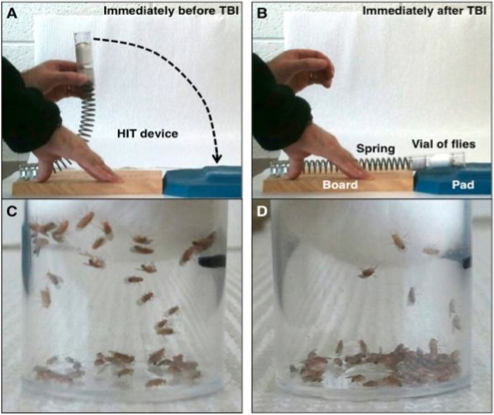Collaborations are underway at University of Wisconsin to probe questions about the long-term consequences of, and potential therapies for, traumatic brain injury in humans.
The answers, according to David Wassarman, a professor of cellular and molecular biology, may lie in fruit flies.

According to the study published last year in the Proceedings of the National Academy of Science by Wassarman and colleagues on the project, traumatic brain injury (TBI) is defined as mechanical damage to the brain.
The major causes of TBI are accidental falls, car accidents, sports collisions and military bomb blasts, which, if not immediately fatal, can lead to downstream problems such as memory loss and suicide. At an estimated 50,000 annual deaths from TBI, it is the largest killer of people under the age of 45, Wassarman said. Yet, he said there are no known drug treatments or therapies specifically tailored for TBI.
Although researchers have been studying fruit flies for more than 100 years, Wassarman said his lab is the first in the world that is looking at fruit flies as an animal model for TBI.
The project got its start when Barry Ganetzky, a professor at the UW Department of Genetics, approached Wassarman after observing what happened after he struck a vial full of flies with large enough force against his hand.
“He didn’t kill them, he knocked them out,” Wassarman says. “[Barry] said to me, ‘Do you think that’s a concussion? Do you think that’s what’s happening to people in car accidents or during football?’ And I’m thinking, yes.”
Wassarman said he saw the need for a device that mimics the same physical forces that underlie concussions — a rapid acceleration and deceleration upon impact — so that his graduate students could safely and quickly do reliable experiments on the flies.
His High Impact Trauma, or HIT, device includes a single spring that, when pulled back and up and then released, hits a vial full of flies that replicates what Ganetzky demonstrated by striking a vial against his hand. The flies, he said, lie at the bottom of the vial for about five minutes before they are able to fly around again.
Wassarman’s lab has already been able to identify genes that are important for controlling the outcomes of TBI based on the percentages of flies that die within 24 hours of being hit with the current device.
“Genetics is really important,” Wassarman said. “If you get hit on the head and I get hit on the head in the exact same way, we’re going to respond differently. That’s what we’ve been doing for the past two years, and we’ve been learning a lot. But this device isn’t perfect.”
This is where bioengineering comes in, Wassarman said. Wassarman approached a Biomedical Engineering Design class to see if a group of undergraduate students would be willing to take on the challenge of improving upon the device as part of their semester-long project, researcher Stephen Schwartz said.
Schwartz, along with Katherine Barlow, Brady Lundin, David Neuser and Katrina Ruedinger, have teamed up to help Wassarman tackle two of the major problems with the current device.
“There’s no way to measure exactly how far you’re pulling it back,” Schwartz said. “Even the same student doesn’t pull it back at the same angle. Another concern was to increase the throughput of the device to speed up the research and run more tests at a time.”
Schwartz said the new and improved device will have four springs that will be latched together at the top and released at once, so that the same amount of force is delivered each time, regardless of who is using it.
Wassarman said he hopes this new device will allow his lab to screen hundreds of thousands of potential drug therapies for TBI. Fruit flies, Wassarman said, have already been tremendous models for human diseases because they are simple animals that share the same basic behaviors of humans.
“I have no reason to believe that a neuron in a fly is any different than a neuron in the human,” Wassarman said. “We think this is going to be a useful system for understanding the fundamental things that are occurring in TBI.”


